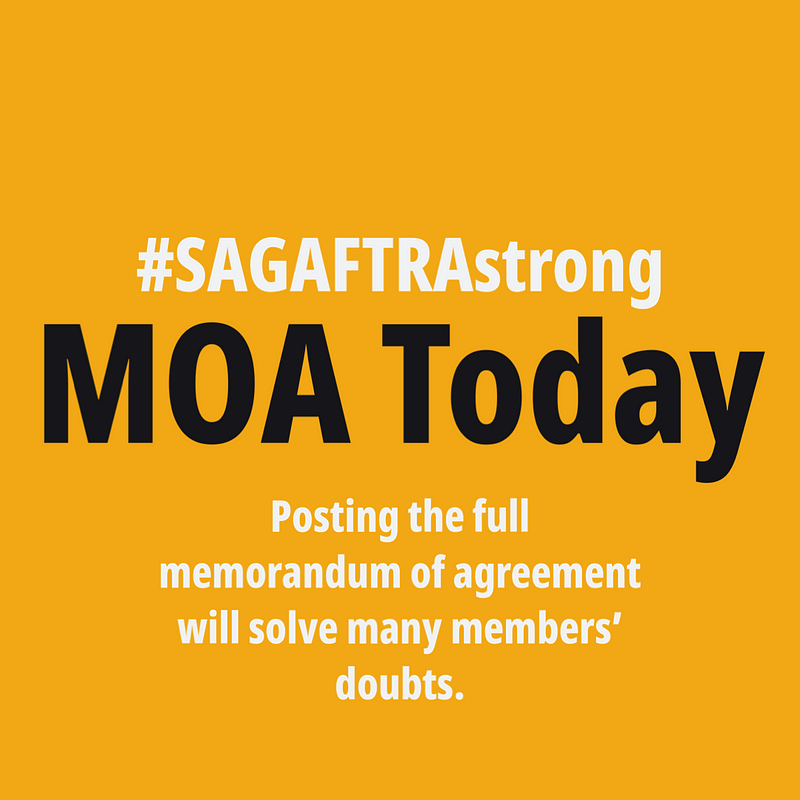Release the SAG-AFTRA MOA Swiftly
Read, Understand, Vote: How Contract Transparency Shapes Decision-Making
Read, Understand, Vote: How Contract Transparency Shapes Decision-Making

People’s hesitance to vote, when it feels like a blind vote, could kill the deal. The SAG-AFTRA tentative agreement likely is truly good enough that, when combined with the legislative, judicial and regulatory efforts being pursued, it gives the protections needed.
As unwieldy as it may be, the entire memorandum of agreement (MOA) itself shared publicly, and soon, may calm things to some degree. That can calm things in a good way. This is not a simple ask, nor something the union can do in an instant.
Setting up hundreds of pages of a contact, and supporting information, so that 160,000 members (and several million others) can access it is something that can be done right, or can be done quickly. And delays may make ratification hard to achieve. Sharing an MOA that does not get ratified, later and after the fact, is not very useful.
And yes, historically we haven’t seen the full MOAs before voting. But conversations now, on the summary alone (which by definition is not complete and so may not seem to include complete protections), are slowly shifting from anxieties into full reservations, and then moving toward firm stances.
If the tentative agreement succeeds or fails on the membership’s congealed worries, then that’s less beneficial than people metaphorically drowning in 1200 pages of legalese.
However the language can be misunderstood cannot be more damaging than how the descriptions of the language are already being misunderstood.
Putting the tentative agreement up to a fully informed vote is the best chance the union, its members (and even the companies on the other side of the deal) have to see this either succeed or clarify what the membership requires in order to move forward. Summaries and info-graphics alone do not accomplish what the full, even unvarnished, MOA can accomplish.
I have never read the entirety of a full US Federal Budget, which is 1,653 pages for 2023 (PDF here), but knowing I could and that it’s available is assuring, affirming and transparent. And I can (and have) run searches for issues relevant to me in it. So too, the full MOA likely can be its own best advocate, but only if it is released publicly, and soon.
To some, rejecting this deal seems to be a risk close to the risk of ratifying it because the language itself is inaccessible. To some, the options to ratify or not seem to be comparable unknowns, because the MOA’s exact language itself is an unknown.
This is the fearful logic I see people falling into:
1 The risk of rejecting the deal: negotiating a better or worse deal instead of this one.
2 The risk of ratifying a not-yet-fully-articulated-or-shared deal: maybe it’s dodging a bullet or maybe it’s looking a gift horse in the mouth.
And 1 or 2 seem comparable because they both seem unknown. Option 2, ratifying the deal, snaps into being knowable the moment the full text of the MOA is accessible.
The MOA itself being not-yet-shared distorts the vote into being about how much people believe the summary reflects what it will be instead of being about what the deal is. The MOA being shared before people vote makes it about what it is supposed to be about: does the tentative agreement give the union members what they need to keep pursuing their careers.
The MOA may be its own best advocate but without it, the full final text, it is almost impossible to know if ratifying or not ratifying is a bigger risk to many people.
Put another way: rejecting a question mark (the unseen MOA itself) to end up with a different thing later might be less bad (in some people’s opinion) than approving a question mark now.
Disclosing the MOA, even awkwardly, may be the best option by being the least bad option. MOA today.
© Copyright November 14, 2023, David August, all rights reserved davidaugust.com
David August is an award-winning actor, acting coach, writer, director, and producer. He plays a role in the movie Dependent’s Day, and after its theatrical run, it’s now out on Amazon (affiliate link). He has appeared on Jimmy Kimmel Live on ABC, on the TV show Ghost Town, and many others. His artwork has been used and featured by multiple writers, filmmakers, theatre practitioners, and others to express visually. Off-screen, he has worked at ad agencies, start-ups, production companies, and major studios, helping them tell stories their customers and clients adore. He has guest lectured at USC’s Marshall School of Business about the Internet.
Subscribe to DDIntel Here.
Have a unique story to share? Submit to DDIntel here.
Join our creator ecosystem here.
DDIntel captures the more notable pieces from our main site and our popular DDI Medium publication. Check us out for more insightful work from our community.
DDI Official Telegram Channel: https://t.me/+tafUp6ecEys4YjQ1




